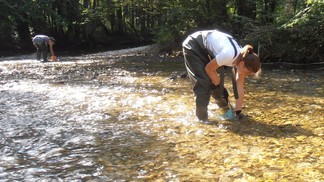Apr 22 2013
Study suggests that artificially imposing a constant flow rate on rivers can have a negative impact on alpine stream ecosystems.
 © 2013 EPFL
© 2013 EPFL
If during a hike in the Alps you have ever fallen when crossing a stream, chances are you stepped on a slippery rock covered by a layer of biological slime, or in scientific parlance: biofilm. Biofilms play in crucial role in alpine river ecosystems, and because of their position at the bottom of the food chain, destruction or loss of biofilm can have far reaching implications. According to a recent study by Serena Ceola, biofilms and the insects that graze them respond negatively to imposed constant river flow rates that are common imposed downstream of diversion points where water is extracted for hydropower production. Her results were published in PLOS ONE on April 16, 2013.
“This is the first time that modeling and tools used in hydrology have been linked to ecology in this way,” says Serena Ceola, who recently completed her PhD at EPFL. For two months, she ran a field experiment in Austria to study the suitability of a range of stream flow conditions to organisms that occupy some of the lowest rungs of the food chain. Working in collaboration with the University of Vienna, she set up 24 flumes - inclined channels designed to replicate idealized alpine streams - as an outdoor laboratory on which she could test a range of different flow conditions.
The process first involved growing biofilm on ceramic tiles that lined the surface of the 24 independent flumes by running water from a nearby lake over them over a period of six weeks. Once a substantial layer of biofilm had accumulated, Serena collected mayfly larvae from a nearby river and let them graze the biofilm, eight per flume. For two weeks, she had to count them every night, replacing any that had died or been washed away. At the end of the experiment, they were sacrificed and their gut contents were analyzed.
The reward for getting her hands dirty was a precious data set that revealed, for the first time, the relationship between stream flow conditions and biofilm growth and insect grazing. Thanks to the controlled conditions of her experimental setup, Serena was able to expose the flumes to a range of different flow and lighting conditions, ranging from constant flow and unimpeded insolation to fluctuating flow rates and partial or total shade.
Tracking the growth of the biofilm and its consumption by the bugs led to two important findings. While both organisms thrive under medium insolation, biofilm grows best under constant low flow conditions, when it is not subject to sudden surges in flow rates that erode the organism by detaching it from its ceramic substrate. The bugs, by contrast, prefer fluctuating flows, which grant them moments of reduced runoff that they take advantage of to graze with a reduced risk of being washed away by the current.
Serena translated her results into mathematical models that relate the stream flow characteristics to the behavior of the biofilm and the bugs. Using these models, she integrated her findings into statistical hydrological models of stream flow. “Using these mathematical models, our results can be extrapolated to entire river catchments, and the effects of altering river flow rates can be studied.”
Though the extrapolation of the results to an entire river basin will be the subject of a future study, the results obtained here have important implications in the management of water resources in alpine environments. The current practice of guaranteeing a minimal constant flow rate for exploited rivers may not do justice to the complex needs of riverbed biology, and could have a negative impact on the biodiversity of fluvial ecosystems.